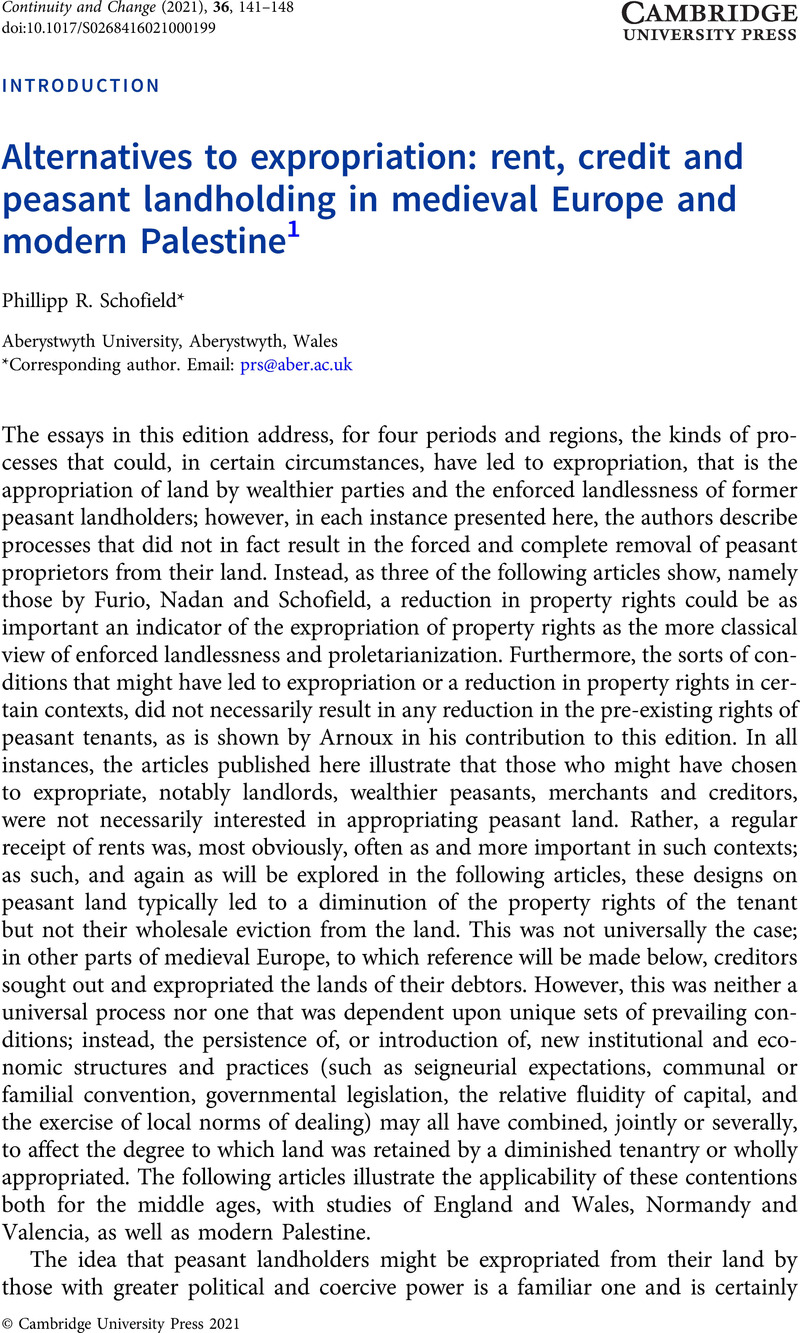Article contents
Alternatives to expropriation: rent, credit and peasant landholding in medieval Europe and modern Palestine
Published online by Cambridge University Press: 21 October 2021
Abstract

- Type
- Introduction
- Information
- Copyright
- Copyright © Cambridge University Press 2021
Footnotes
The papers included in this collection were presented to a session of the World Economic History Congress, Boston, August 2018. The authors are grateful for the comments of participants in that session and for the later advice of anonymous referees and the journal editors. The stated objective for panellists was to fill the gap in understanding the extent to which insolvency and non-payment were a dominant cause of land seizure from peasants. The initial intention was to compare different practices and contexts, and to draw more general conclusions about the role of rural credit and indebtedness in the peasant land market. The approach has been widened here to accommodate other discrete features which aid our understanding of how and under what conditions peasants retain land, despite the kinds of pressures that, in other contexts, lead to expropriation.
References
Notes
2 Marx, Karl and Engels, Friedrich, Capital: A Critique of Political Economy (New York, 1967)Google Scholar.
3 See, for example, Pinto, G., ‘Note sull'indebitamento contadino e lo sviluppo della proprietà fondiaria cittadina nella Toscana tardomedievale’, Ricerche Storiche 10 (1980), 3–19Google Scholar, and ‘Mezzadria poderale, contadini e proprietari nel catasto fiorentino del 1427’, Società e Storia 12 (1981), 459–68; Piccinni, G., ‘Seminare, fruttare, raccogliere’. Mezzadri e salariati sulle terre di Monte Oliveto Maggiore (1374–1430) (Milan, 1982)Google Scholar; Cherubini, G., L'Italia rurale nel basso medioevo (Bari, 1984)Google Scholar.
4 Guy Bois, ‘Against the neo-Malthusian orthodoxy’, in T. H. Aston and C. H. E. Philpin, eds., The Brenner debate. Agrarian class structure and economic development in pre-industrial Europe (Cambridge, 1985), 113–14.
5 Pinto, ‘Note sull'indebitamento contadino’.
6 M. Borrero Fernández, ‘Efectos del cambio económico en el ámbito rural. Los sistemas de crédito en el campo sevillano (fines del siglo XV y principios del XVI)’, in M. A. Ladero Quesada, ed., En la España Medieval V. Estudios en Memoria del Profesor D. Claudio Sánchez Albornoz (Madrid, 1986), 219–44; A. Furió, ‘Diners i crèdit: els jueus d'Alzira en la segona meitat del segle XIV’, Revista d'història medieval 4 (1993), 127–60; M. Berthe ed., Endettement paysan et crédit dans l'Europe médiévale et moderne (Toulouse, 1998); P. Schofield and T. Lambrecht eds., Credit and the rural economy in North-Western Europe, c. 1200-c. 1850 (Turnhout, 2009).
7 C. D. Briggs, Credit and village society in fourteenth-century England (Oxford, 2009); Julie-Mayade Claustre ed., La Dette et le juge. Juridiction gracieuse et jurisdiction contenieuse du XIIIe au XVe siècle (Paris, 2007).
8 Among numerous studies exploring the development of a medieval land market see, for instance, L. Feller and C. Wickham eds., Le marché de la terre au Moyen Âge (Rome, 2005).
9 R. Brenner, ‘Property and progress: where Adam Smith went wrong’, in C. Wickham ed., Marxist history writing for the twenty-first century (Oxford, 2007), 86–7.
10 Brenner, ‘Property and progress’, 87.
11 Brenner, ‘Property and progress’, 88; E. A. Kosminsky, Studies in the agrarian history of England in the thirteenth century (Oxford, 1956), 198.
12 Rodney Hilton, ‘Why was there so little champart rent in medieval England?’, The Journal of Peasant Studies 17, 4 (1990), 509–19.
13 Bailey, M., ‘Peasant welfare in England, 1290–1348’, Economic History Review 51 (1998), 233CrossRefGoogle Scholar.
14 C. Wickham, in exploring the operation of the economy within medieval feudal society, observes that nascent and increasingly persistent commercial structures facilitated the peasant hold on land through a process of ‘commercial solidity’, some level of commercial exchange supporting both lords and peasants: ‘How did the feudal economy work? The economic logic of medieval societies’, Past and Present 251, 1 (2021), 29–30, 36–8.
- 1
- Cited by





